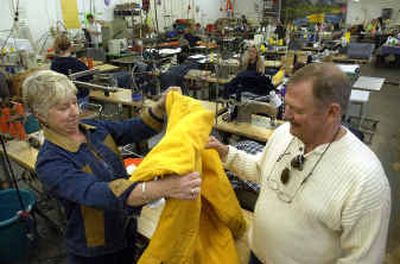Couple’s designs can take the heat

KELLOGG — Larry Stinson once thought that successful small companies eventually passed some kind of magic mark. It might be a big sale, or perhaps a new client.
Whatever it was, passing the mark resulted in security and everlasting prosperity for the firm. “That point where you’d live happily ever after,” Stinson said, chuckling at the memory.
Stinson and his wife, Brenda, own Silver Needle Inc., a Kellogg company that makes safety clothing for workers. After 25 years in business, they know this: Small companies never have the luxury of resting on past achievements.
“You have to anticipate,” Larry said. “Stay ahead of what is changing.”
The Stinsons have remade Silver Needle several times. By designing products like “chainsaw chaps” to protect firefighters and leggings for smelter workers, they’ve kept Silver Needle competitive and growing. The company employs 40 people. Last year its sales were in the $1.5 million range.
Brenda, a self-taught seamstress with a fine arts degree, designs most of the clothing. Her latest is a “flash suit.” A welder working on a natural gas line would wear it to protect against burns from flammable vapor.
“If it’s hot, we do it. If it explodes, we do it. If it burns, we do it,” Brenda said.
Brenda launched Silver Needle from the couple’s back bedroom in 1979, sewing supply bags with a friend to sell to local miners. It’s an entrepreneurial story that Small Business Administration officials love to tout. Next month, the couple will be honored as the SBA’s “Small Business Persons of the Year” from Idaho’s 10 northern counties.
“They have a wonderful story and a very innovative product,” said Sharon Russell, SBA development specialist in Spokane. “They’ve contributed a lot to the local economy.”
Silver Needle took off in 1981, when Larry and Brenda both lost jobs at the Bunker Hill Mine. The mine and its smelter complex shut down, laying off more than 2,000 people in Idaho’s Silver Valley.
Larry, an engineer, had a job offer in Arizona. “You can go and mail the checks, because I’m staying here,” Brenda told him.
For six years, the couple lived off their ranch while Silver Needle was getting established. Larry logged; Brenda grew all the family’s vegetables. Sometimes, they stayed up until midnight finishing orders.
“We didn’t collect a paycheck for six years,” Larry said.
But Silver Needle’s reputation grew. Miners told other miners about their products. Companies called the couple after accidents. Northwest Alloys in Addy, Wash., contacted them after a worker was badly burned in the groin, Brenda said. “Their protective clothing wasn’t doing the job.”
She designed a garment the workers called “Hugglies.” It fit a bit like a diaper, covering and protecting the employees’ midriffs from splashes of molten metal.
Northwest Alloys became Silver Needle’s largest customer, so the plant’s closure in 2001 was a serious blow to the Kellogg company. Over about a year, Silver Needle lost all of its smelter customers in the Northwest. “Every one of them closed,” Brenda said.
The company pursued other industries. But over time, the smelter closures here produced a silver lining. The safety directors had scattered to new jobs all over the country, but they hadn’t forgotten Silver Needle.
“All these other smelters and foundries started calling us with orders,” Brenda said.
Silver Needle’s strength is its product design, said Al Wickstrom, general manager at Sound Safety Products in Everett, Wash., which sells safety garb to the utility, shipyard and chemical industries.
“They’re more responsive than bigger manufacturers for product development,” he said. When Wickstrom’s customers need safety clothing that’s not available elsewhere, he often sends them to Silver Needle.
Brenda and her staff work closely with customers, choosing the appropriate materials and trying out designs.
“We take a match to everything to make sure it stands up,” Brenda said. “You just can’t buy any old material, make a product and sell it.”
Larry sends out “test kits” of prototypes to companies. They splash the clothing with molten metals, expose it to flame and flammable gasses, and put it through the same conditions their workers might experience during an accident. Layers of film behind the clothing measure the heat transfer, indicating how severely the worker would be burned.
Protective materials can run $80 per yard or more. “That’s $6,000 worth,” said Brenda, pausing to pat a pile of foil-covered hides in Silver Needle’s storeroom. The leather will be made into protective coats for smelter workers.
Brenda and Larry’s office is full of innovations: Pockets for radios on safety vests. Safety garments for utility workers that look like regular sweatshirts. A copy of new safety regulations for electrical workers.
“There’s no drifting,” Larry said.
“You have to keep growing and changing,” Brenda said.